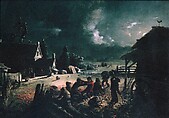Corn Husking
David Gilmour Blythe American
Not on view
Blythe, who lived in Pittsburgh, Pennsylvania, painted satires, mainly of urban ills, but in "Corn Husking," he portrayed their rural counterpart. The work depicts a sudden outbreak of violence on an eerie, moonlit night among a group of boys engaged in the taxing and tedious task of husking recently harvested corn. The farm is dilapidated and the farming implements are carelessly strewn around the property, conveying the harsh realities of the setting. Blythe pointedly made poverty and discord the crux of a theme that is usually associated with abundance and harmony.
Due to rights restrictions, this image cannot be enlarged, viewed at full screen, or downloaded.

